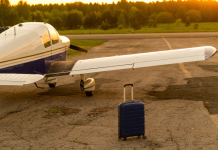You never know when you’re going to run out of luck, do you? And on this day, now many years ago, I experienced a near miss that really shook me.
Like other such incidents I have read about in your magazine, my day began like any other, with no hint of the drama ahead.
I was a young instructor, with about 270 hours of instruction out of a total flying time of 700 hours.
The student and I left Bankstown in a Cherokee to do stalling exercises in the training area which was designated as a danger area due to the volume of aircraft.
Once clear of the control zone, we could climb to 4,000 feet – the lower limit of the controlled airspace step.
As usual, we did a 180-degree clearing turn and, not sighting any other traffic, began our climb. No radio calls were required or given for entering the training area/danger area; however, that area was very busy, at the time this incident took place.
So we were climbing in a slow orbit and everything was okay. We weren’t talking – the student was concentrating on doing a proper rate-one, left-hand climbing turn.
But suddenly he shot his arm out and shouted something! He let go of the controls! I got a huge fright, of course, not knowing what he was doing. And then I saw it! Another Cherokee was terrifyingly close, crossing from right to left. It filled the windscreen!
My heart was pounding in my ears as I grabbed the yoke and pushed forward.
The other aircraft passed very close – maybe only 50 feet away (15 metres)! I could easily read the registration, along with seeing rivets and oil and mud stains on the underside of the fuselage!
The near miss was over in a second or so and maybe it was never going to hit us but I was stunned that we had come so close, with no warning. It really shook me up. And I immediately began to second guess myself. Was this my fault? Had I stuffed up? Why hadn’t we seen the other aircraft? Had that pilot seen us?
I was then surprised by the after-effects – adrenalin kicked in and my blood pressure spiked.
Fortunately, I had enough training to keep the aircraft straight and level while the student and I took a breath and regained our composure. But I had to admit my concentration (and perhaps confidence, momentarily) was shot and I opted to end the lesson early. I remember saying to him, ‘Peter, I just can’t continue this flight, that was just too close.’
I felt quite okay by the time we had landed but didn’t restart the lesson as I had other fish to fry: namely, did the other pilot see us?
As I had seen the rego of the aircraft and recognised the colour scheme of the rival flight training organisation, I called their office and managed to get the other instructor on the line after a few minutes.
‘No,’ that instructor said down the line. ‘We didn’t see you at all! This is the first I’ve heard of your aircraft coming close to us.’
Which means what, exactly? Were we and the pilots of the other aircraft ‘keeping our heads in the cockpit’ too much and simply not keeping a good enough lookout? Or was it just bad luck to converge on the same spot at the same altitude? And does that mean there’s nothing anyone can do to reduce the risk of flying in close proximity to other aircraft?
Or is the risk of a mid-air collision very low, due to our current practice of using the radio for ‘alerted see-and avoid’, so perhaps we don’t have to worry too much or catastrophise about ‘what ifs’?
Another Cherokee was terrifyingly close, crossing from right to left. It filled the windscreen!
Reprieve and aftershock
One of the reasons I’ve written about my incident was the mid-air collision near Sydney in October last year that killed 3 people, including a very experienced Qantas captain.
It revived memories of the dread and fear that filled me for years after my near miss. I guess I had a form of PTSD, thinking that I could have had the same fate.
Also, in 2008 there was another mid-air collision, near the ABC 2RN radio mast. The ERSA entry for Bankstown says arriving VFR aircraft should track via and report at Prospect or 2RN.
Analysis done by the ATSB confirms that it is difficult to see an oncoming aircraft until it’s right on top of you. So while TCAS and ADS-B are good, we still need to keep a good lookout.
I went on to fly many types of aircraft, including King Airs and the Hawker 800. In 18,000 hours, I was never so frightened again.
Lessons learnt
This incident reinforced to me the importance of speaking up and making radio calls to alert other traffic of your presence, which is even more important in a busy training area. Alerted see-and-avoid is a good system – if everyone practises it – but it’s not perfect and we need to keep our heads outside the cockpit as much as we can.
In the years since the incident, all IFR aircraft – and many VFR – have installed ADS-B OUT and IN. The Australian Government is offering a subsidy for installing these units to make our aircraft visible to other aircraft and to ATC.
I use an EFB for situational awareness, such as to detect Dash 8s and Saabs approaching CTAF aerodromes, but I’m very conscious of the necessity to keep a constant visual watch for other aircraft.
Non-controlled operations is one of the special topics on our Pilot safety hub. Refresh your knowledge at casa.gov.au/pilots.
Have you had a close call?
8 in 10 pilots say they learn best from other pilots and your narrow escape can be a valuable lesson. We invite you to share your experience to help us improve aviation safety, whatever your role.
Find out more and share your close call.
Disclaimer
Close calls are contributed by readers like you. They are someone’s account of a real-life experience. We publish close calls so others can learn positive lessons from their stories, and to stimulate discussion. We do our best to verify the information but cannot guarantee it is free of mistakes or errors.





